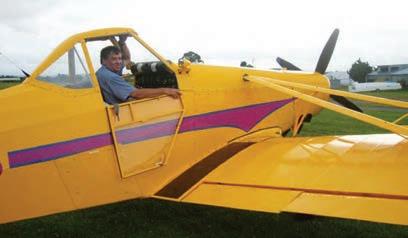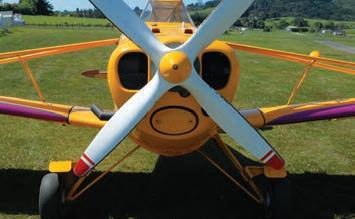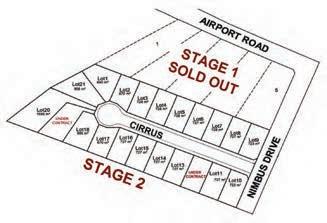
8 minute read
Tow Pilot
from SoaringNZ Issue 2
by mccawmedia
In March 1991, after 622 hours, during a 100 hour inspection evidence of metal in the oil was found during an oil contamination test. We continued operating but with constant engine monitoring until the time came that we could not continue. The engine was stripped and it was found that some cam lobes were trying to change from being egg shaped to being perfect circles. Once the cam’s hardened surface has been damaged, this happens quite quickly. This is a real problem with Lycoming engines where the camshaft is above the crankshaft and depends on splash feed lubrication. With a hot engine (and hot low viscosity oil) after a glider tow the pilot should ensure that the RPM is kept up to keep a good splash oil supply to the cam lobes. The cam and bearings were replaced with new ones and at the same time the engine was fitted with a new set of rings. The engine then performed OK except that we had an ongoing problem with magnetos. One even came mechanically apart while in flight. The capacitor inside the magneto has a small wire from it to the points and that wire was continually breaking. We even had both mags hiccup during one launch, which gave the pilot a strong urge to get back on the ground fast.
We kept the engine going despite the magneto issues until May 1994 (at 1660 engine hours) when we replaced all 6 pots with new ones. CEB was going to Omarama for the World Gliding Champs at the end of that year. We figured that continually having to change and clean plugs would not be a good look. The aircraft performed well at Omarama. One thing I did find down there was that it would not go above 9500 feet towing a glider (but that’s another story).
Advertisement
Not all the major (and expensive) issues have related to the engine. In August 1994 while landing at the Pukekohe East strip, the pilot miscalculated his landing roll and managed to use the left wing as a brake, against a fence which protruded out from the airfields boundary. The wing was removed and most of the leading edge ribs were replaced with pressed ribs purchased from Univair in the USA. The usual rib construction for Pawnee and Cubs are small individual pieces all riveted together (presumably for good employment opportunities during the great depression). Univair have available pressed ribs which have an STC approval.
In the mid 90’s there was an increasing concern about the problems with the fuse main spar carry through fittings. Apparently a Pawnee spraying in the USA had a wing fall off because of
The author in Auckland’s lovingly maintained and restored Pawnee.
attachment point corrosion. The NZ CAA introduced a mandatory inspection (DCA PA-25 124). I was concerned that in 1988 we had major corrosion issues in the forward fuse area and there could be a problem with the attachment points. The original fittings are made up units welded to the bottom longeron and with the wing removed the longeron could be seen through the fitting. A company called KASOLA in the USA had developed an STD’d mod to replace the original fittings with a 1 piece forged fitting. This fitting is then welded into the existing structure. In September 1996, we went ahead and carried out this KASOLA mod which effectively cancelled DCA PA-25 124. It also made me feel a little happier, knowing the lower tubes were OK. After welding, the tubes were filled / washed with linseed oil.
However back to the engine …. In August 1995 at 1904 engine hours, again during a 100 hour inspection, it was discovered that the engine case was cracked. A replacement case was located and a full bottom end overhaul carried out (new bearings, the lot). During this overhaul, we did discuss the option of a total overhaul (ie zero time) however we decided against it because the cylinders had only 300 hrs on them and because of the costs involved. We did however effectively carry out a full overhaul on the bottom end including the accessory case. All then went well for the next few years (except for the ongoing and expensive magneto problems) until November 2000 (3007 hours TT). Again we found metal traces in the oil and the usual camshaft problems, again, a replacement camshaft and bearings.
Since the last engine repair in 2000, the engine has been going quite well. However we still have made a number of changes and improvements. In 2003 I resigned as the CTP for the Auckland Club. Tony Leggatt took over, however in 2005 Tony resigned and I was asked to do the job again.
While responsible for CEB, Tony incorporated two specific changes which I believe have had a major impact on the overall reliability of the engine. As I have previously mentioned, I have never been really comfortable with the 4 blade prop. The ongoing magneto problems, starter problems and elevator vibration seemed related to the prop. When Tony was in charge, he contacted Hoffman who really had no answer but sent him a drawing for a heavy metal disc behind the prop. He had this disc made up and installed. Believe it or not, we have had no problems with the magnetos or starter since. (3 years now). It also has improved the C of G, bringing it further forward.
Looking into this a little further, every certified engine for a certified aircraft has a crankshaft counterweight combination which is set up for specific engine / airframe / propeller combinations. The idea is to keep any harmonic resonance problems for that specific installation to a minimum. Changing any part of that combination can affect engine vibration levels. It is assumed that the Hoffman prop being a light weight prop would have less harmonic issues than a heavier metal prop. That is correct, but two issues have to be
considered. The first is the blade area as compared with the prop inertia. The Hoffman prop obviously has roughly twice the blade area as a 2 blade metal prop but significantly less weight / rotating inertia. As the prop rotates, it will slow down more between each firing cycle and on a firing pulse, will speed up more. The other issue is the engine crankshaft counter weight combination which is designed to cancel out specific harmonics. … but only with the certified propeller. It is logical then that when driving a “light weight” propeller like the 4 bladed Hoffman, the engine counterweight combination can actually generate more harmonic problems. So I believe the disc has made a major improvement to reliability when using the Hoffman 4 blade prop by increasing the total rotating mass.
The other thing Tony installed is a cylinder rate of temp change indicator. This presents to the pilot a flashing light if the recommended Lycoming “rate of change” rates are exceeded. Normally the light is out, but if sensed, will flash at an increasing rate depending on the value of the “rate of change” Any change in airspeed or engine RPM has an instant effect on the flash rate and it is very easy to develop a descent technique so there is no flashing at all. I believe that this instrument also has greatly improved the long term reliability of the engine - again reflected in the lack of any major engine problems over the last few years. Finally, the cowl flap was removed because Tony considered it really was no help in controlling cylinder head temperature (and I agree).
In 2005 the Club Committee decided to follow the Australian example by installing an LS-1 V8. This project is under the control of Shane Brown. As the overall condition of CEB had deteriorated we decided to begin a reasonably intense refurbish but keeping close control of costs. So in June 2006 we pushed it into the back of the hangar and I proceeded to pull it apart. In December, I carried out
The heavy metal disc can be seen behind the prop.

a test flight and it has been performing really well ever since. While I did all the engineering work, the fabric work was done by Mark Morley and all the painting was done by Lindsay Stephens with our club treasurer Neville Drake doing all the pickups and delivery work. I would also mention the support we have had from Greg Ryan from Aerotech. The depth of his engineering skills and experience has been of great help to the club for many years.
A very limited budget meant care had to be taken with every expense. In the end, the cost was close to $10,000 which is an excellent result. Lindsay’s choice of colour had me a little worried at first but yellow with a purple and blue trim has the advantage of not needing any flashing lights as the whole aeroplane becomes one.
Finally, what does the future hold? Fuel costs aside, there is no question that the Pawnee or a similar configuration is hard to beat as a glider tug. Engine maintenance however is becoming increasingly expensive. The automotive engine option is fast becoming reality with the Australian V8 operating well. I believe that the NZGA need to take this issue on board as a service to the gliding movement and along with the Australian Gliding Federation create a united front to CASA and the NZ CAA with the object of creating a special Glider tug category which gives a restricted use of specific automotive conversions installed to an existing type certified airframe.
“The Local Firm” A C SPIVEY REAL ESTATE LTD M.R.E.I.N.Z
OMARAMA AIRFIELD STAGE 2 SUBDIVISION Prime Residential Sections at Affordable prices
LOT PRICE
1 $115,000 2 $90,000 3 $95,000 4 $95,000 5 $95,000 6 $95,000 7 $95,000 8 $95,000 9 $105,000
LOT PRICE
10 $105,000 12 $95,000 13 u/contract 14 $95,000 15 $95,000 16 $95,000 17 $95,000 18 $90,000 19 $105,000
LOT PRICE
19 u/contract 20 $120,000 21 $125,000

N.B. All measurements are approximate and subject to final survey.










